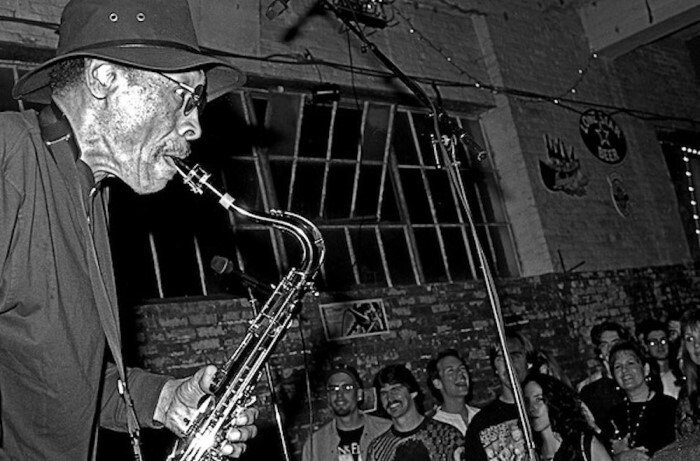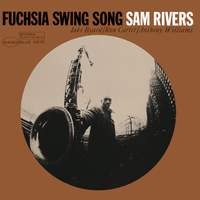Artist Profile,
Sam Rivers
 Of the great saxophonists who came to prominence in the fifties and sixties, Sam Rivers remains one of the most under-appreciated and least understood. A player out of step with his bebop and hard bop peers, it took the arrival of the avant-garde for Rivers to find his natural home, playing with musicians often several decades his junior. His approach to improvisation was intellectually rigorous, which sometimes gave his music a rather austere flavour that can take a while to lock into (unlike Eric Dolphy for example, whose acrobatic melodic shapes are easier to grasp on first encounter). However, Rivers will reward the engaged listener with music of immense depth, and a compelling push and pull between tunefulness and experimentation. Over the years his reputation has only increased, with a loyal following hungry for his harmonic invention, oblique rhythmic impulses and mastery of not just the saxophone family but also flute.
Of the great saxophonists who came to prominence in the fifties and sixties, Sam Rivers remains one of the most under-appreciated and least understood. A player out of step with his bebop and hard bop peers, it took the arrival of the avant-garde for Rivers to find his natural home, playing with musicians often several decades his junior. His approach to improvisation was intellectually rigorous, which sometimes gave his music a rather austere flavour that can take a while to lock into (unlike Eric Dolphy for example, whose acrobatic melodic shapes are easier to grasp on first encounter). However, Rivers will reward the engaged listener with music of immense depth, and a compelling push and pull between tunefulness and experimentation. Over the years his reputation has only increased, with a loyal following hungry for his harmonic invention, oblique rhythmic impulses and mastery of not just the saxophone family but also flute.
Born in El Reno, Oklahoma in 1923 to a musical family, Rivers’s father was a church musician who frequently toured with a gospel quartet, and his mother taught music and sociology at the privately owned Shorter College, run by and for African Americans. Rivers started out on piano and violin at the age of five, then moved on to trombone for a few years, before settling on tenor sax as his primary instrument. Drafted into the Navy in the forties and stationed in California, he spent some time performing with the blues singer Jimmy Witherspoon, as well as starting his own small groups. In 1947 he went to study at the Boston Conservatory, where his professor was Alan Hovhaness, a composer with a strong mystical bent who introduced Rivers to non-Western musics, and encouraged him to challenge musical orthodoxy. Throughout the fifties Rivers played with a diverse range of musicians, including Jaki Byard, Nat Pierce, Quincy Jones, Serge Chaloff, and made his first appearance on Blue Note as a sideman for Tadd Dameron.
His most significant musical partnership was with a then 13-year old Tony Williams, something of a kindred spirit, and the two would go on to play together in various settings through the sixties. It was on Williams’s recommendation that Rivers was briefly hired to join the Miles Davis groups for a tour of Japan, which made it to record, but their styles didn’t really mesh; Davis didn’t care for Rivers's avant-gardisms, and besides, he was holding out for Wayne Shorter to become available. Rivers was far more comfortable with similarly experimental artists such as Cecil Taylor, Bill Dixon and Archie Shepp, but also at home in a wide range of settings, and his appearances as a sideman on several Blue Sessions of the sixties are often the highlights of those records; these include sessions with Bobby Hutcherson, Andrew Hill, and Tony William’s brilliant Life Time and Spring.
 In the seventies Rivers became one of the prime movers at the heart of New York’s ‘loft’ scene, with his wife Bea setting up ‘Studio Rivbea’ in the NoHo district. The loft scene was a way for experimental artists to sidestep the commercial pressures of filling nightclubs or concert halls, offering the freedom to improvise without limitation. Many of these informal concerts were recorded and released in several volumes as the Wildflowers series (currently out of print), and feature a who’s-who of cutting-edge jazz artists in the seventies; Anthony Braxton, Marion Brown, Dave Burrell, Andrew Cyrille, Oliver Lake, Jimmy Lyons, Ken McIntyre, Kalaparusha Maurice McIntyre, Roscoe Mitchell, and David and Sunny Murray.
In the seventies Rivers became one of the prime movers at the heart of New York’s ‘loft’ scene, with his wife Bea setting up ‘Studio Rivbea’ in the NoHo district. The loft scene was a way for experimental artists to sidestep the commercial pressures of filling nightclubs or concert halls, offering the freedom to improvise without limitation. Many of these informal concerts were recorded and released in several volumes as the Wildflowers series (currently out of print), and feature a who’s-who of cutting-edge jazz artists in the seventies; Anthony Braxton, Marion Brown, Dave Burrell, Andrew Cyrille, Oliver Lake, Jimmy Lyons, Ken McIntyre, Kalaparusha Maurice McIntyre, Roscoe Mitchell, and David and Sunny Murray.
Rivers’s discography as leader starts with four incredibly colourful and varied albums for Blue Note - Fuchsia Swing Song, Contours, A New Conception, and Dimensions & Extensions - and then after a few recordings for Impulse! continued largely on various independent imprints in the seventies and beyond, right up until his death in 2011 at the age of 88. I have tried to cover some of Rivers’s key recordings here, and although they come and go in print we are fortunate that so much good stuff is now available to download.
Debut albums don't come much more accomplished than this (not surprising considering Rivers was 41 at the time) Fuchsia Swing Song demonstrates that River was a masterful hard bop player, as his joyful solo here on Downstairs Upstairs Jump shows. Nestled amongst the exhilarating straight-ahead barnstormers is ‘Beatrice’, a tender ballad dedicated to the love of his life, and one of his few compositions to make it into the wider repertory. Jaki Byard and Ron Carter are in great form, and an 18 year old Tony Williams simply rewrites the rule book as to what the drummer is expected to do.
Available Formats: MP3, FLAC, Hi-Res FLAC, Hi-Res+ FLAC
Tony Williams’s debut Life Time reaches considerably further into free jazz territory than Fuchsia Swing Song. Rivers’s marvellous solo on the ‘Red’ section of the sidelong ‘Two Pieces of One’ suite is cool and abstract, syncing perfectly with a young Bobby Hutcherson’s vibraphone. Rivers resists the impulse to go feral until he finally lets rip in the ‘Green’ section, making this an early highlight from his discography.
Available Formats: MP3, FLAC
1967’s Contours finds Rivers increasing the avant-garde quotient considerably, and whilst he’s still playing with a post-bop backing (Joe Chambers particularly notable on this session for the numerous tiny percussive details he drops in to vary the beat) Contours stands with Out to Lunch and Unit Structures as one of Blue Note’s more experimental releases of the era. On ‘Point of Many Returns’ we hear that coiling, slithering quality on Rivers’s soprano that became such a trademark, and Freddie Hubbard shows once again how adept he could be in more experimental music.
Available Formats: Vinyl Record, MP3, FLAC, Hi-Res FLAC
Recorded live at the 1973 Montreux Music Festival, Streams (by Sam RIVERS - get it?) offers a continuous 50 minutes of Rivers at his most uncompromising, finally free of any bop trappings. Bassist Cecil McBee and drummer Norman Connors offer elastic rhythms that twist and turn to support Rivers as he ploughs through numerous contrasting sections. It’s exhilarating music, and whether on sax, flute or even Cecil Taylor-inspired piano, Rivers maintains the sense of narrative, always moving things forward.
Available Formats: MP3, FLAC
A slightly more restrained set from the seventies, his only recording for ECM Contrasts is a rewarding, diverse album, that has an expanded palette including George Lewis’s ever memorable trombone. Rivers’s flute playing is more light-hearted in tone compared to his sax, which is underlined on this album’s centrepiece ‘Verve’. From the first unaccompanied notes Rivers, and Thurman Barker quickly sets up a mellow vibe with a suitably lazy mid-tempo backbeat. Dave Holland gets in a corker of a bass solo, and the tone becomes increasingly more surreal, with Rivers switching to birdlike sax harmonics at the close. ‘Lines’ features some of the man’s finest soprano playing, and George Lewis does rude things on the fast yet light ‘Dazzle’.
Available Formats: MP3, FLAC, Hi-Res FLAC







